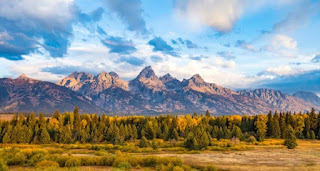Grand Teton, Foxes, and Mountains
Not too long ago, we discussed some interesting things about Yellowstone National Park. Now we can go just a short distance south and take in Grand Teton National Park. Folks in the formerly United States may want to experience nature there in autumn.
Many things are happening, including migrations of birds and animals. The wildlife is diverse, and foxes are prominent there. Have you ever seen those pictures that say, "Firefox has crashed", and it shows a fox half buried head first in the snow?
 |
| Grand Teton National Park, view from Blacktail Ponds, National Park Service / J. Tobiason (usage does not imply endorsement) |
The Tetons are considered the youngest part of the Rocky Mountains (and way down south, the Andes are a kind of continuation of the Rockies — or is that the other way around?), and the Tetons are troubling to believers on uniformitarianism. Notice that "the present is the key to the past" doesn't exactly work in explaining the youthful features of the Tetons, and there are no mountain-making geological activities observed today. Were these the product of the Genesis Flood? No. Yes. Indirectly.
Just south of Yellowstone National Park lies one of the most picturesque mountain ranges in the western United States—the Teton Range, established as a national park in 1929. When viewed from the east, the Tetons seem to shoot straight out of the plains. Their stark, jagged peaks rise to heights above 13,000 feet, while the valley floor with its sage and wildlife lies at only 6,000 to 7,000 feet.
Grand Teton National Park’s wide variety of animals, including foxes, showcase out-of-this-world innate engineering. Plus, the park’s rocks carry clues to a catastrophic start and an icy finish. Let’s see where those clues lead.
You can read the rest if you hike on over to "Grand Teton National Park: the Youngest Rocky Mountains."